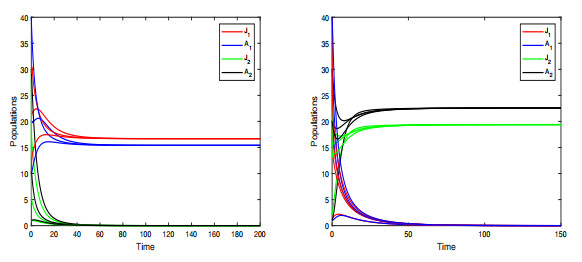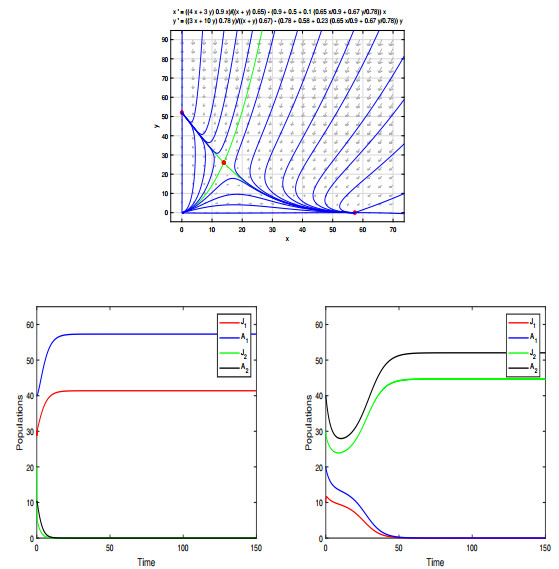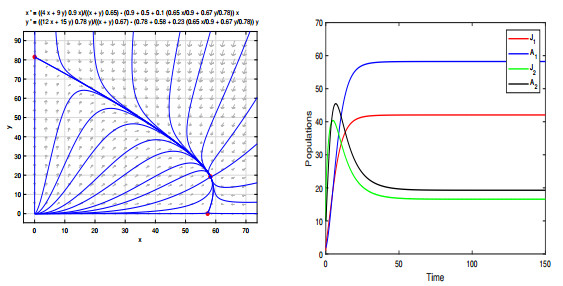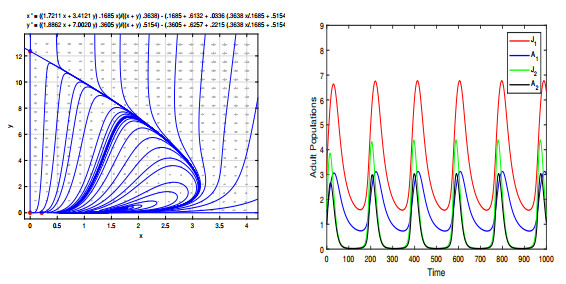| Citation: | Chuihong Yang, Xinan Zhang, Jia Li. COEXISTENCE FROM INTERSPECIFIC MATINGS FOR MOSQUITOES WITH STAGE STRUCTURE[J]. Journal of Applied Analysis & Computation, 2022, 12(3): 1043-1061. doi: 10.11948/20220106 |
COEXISTENCE FROM INTERSPECIFIC MATINGS FOR MOSQUITOES WITH STAGE STRUCTURE
-
Abstract
Stage-structured models, including groups of larvae and adults, for two interacting mosquito species are studied in this paper. When there are no interspecific matings, the model dynamics follows the competitive exclusion principle such that only one of the two species can survive and there is no coexistent positive equilibrium. As interspecific matings take place, the interactive dynamics become complex. One of the two species can still dominate and drive the other species extinct with no existence of positive equilibrium, either species can survive or die out depending on initial sizes of the species where there exists an unstable positive equilibrium, or the two species coexist with a locally asymptotically stable positive equilibrium under certain conditions. Other dynamical features can occur as well. Detailed mathematical analysis and numerical examples are provided. Brief biological discussions are also given.
-
Keywords:
- Mosquito population /
- stage structure /
- interspecific matings /
- competitive exclusion /
- coexistence /
- stability
-

-
References
[1] B. W. Alto, L. P. Lounibos, S. Higgs and S. A. Juliano, Larval competition differentially affects arbovirus infection in aedes mosquitoes, Ecology, 2005, 86(12), 3279-3288. doi: 10.1890/05-0209 [2] I. Bargielowski, E. Blosser and L. P. Lounibos, The effects of interspecific courtship on the mating success of aedes aegypti and aedes albopictus (diptera: culicidae) males, Ecol. Popul. Biol., 2015, 108(4), 513-518. [3] N. Becker, Mosquitoes and Their Control, Kluwer Academic/Plenum, New York, 2003. [4] M. A. H. Braks, N. A. Honório, L. P. Lounibos, R. Lourenço-De-Oliveira and S. A. Juliano, Interspecific Competition Between Two Invasive Species of Container Mosquitoes, Aedes aegypti and Aedes albopictus (Diptera: Culicidae), in Brazil, Ann. Entomol. Soc. Am., 2004, 97(1), 130-139. doi: 10.1603/0013-8746(2004)097[0130:ICBTIS]2.0.CO;2 [5] C. Dye, Intraspecific competition amongst larval aedes aegypti: Food exploitation or chemical interference, Ecol. Entomol., 1982, 7(1), 39-46. doi: 10.1111/j.1365-2311.1982.tb00642.x [6] R. M. Gleiser, J. Urrutia and D. E. Gorla, Effects of crowding on populations of aedes albifasciatus larvae under laboratory conditions, Entomologia Experimentalis et Applicata, 2000, 95(2), 135-140. doi: 10.1046/j.1570-7458.2000.00651.x [7] A. Giatropoulos, D. P. Papachristos, G. Koliopoulos, A. Michaelakis and N. Emmanoue, Asymmetric mating interference between two related mosquito species: aedes (stegomyia) albopictus and aedes (stegomyia) cretinus, PLoS One, 2015, 10(5), e0127762. https://doi.org/10.1371/journal.pone.0132862. doi: 10.1371/journal.pone.0132862 [8] S. Juliano, L. Lounibos and G. O’Meara, A field test for competitive effects of Aedes albopictus on A. aegypti in South Florida: differences between sites of coexistence and exclusion? Oecologia, 2004, 139(4), 583-593. doi: 10.1007/s00442-004-1532-4 [9] B. Kesavaraju, P. T. Leisnham, S. Keane, N. Delisi and Rachel Pozatti, Interspecific Competition between Aedes albopictus and A. sierrensis: Potential for Competitive Displacement in the Western United States, PLoS ONE, 2014, 9(2), e89698. https://doi.org/10.1371/journal.pone.0089698. doi: 10.1371/journal.pone.0089698 [10] J. Li, Simple stage-structured models for wild and transgenic mosquito populations, J. Diff. Eqns. Appl., 2009, 15(4), 327-347. doi: 10.1080/10236190802566491 [11] J. Li, Malaria model with stage-structured mosquitoes, Math. Biol. Eng., 2011, 8(3), 753-768. [12] Z. Liu, C. Tian and S. Ruan, On a network model of two competitors with applications to the invasion and competition of aedes albopictus and aedes aegypti mosquitoes in the United States, SIAM J. Appl. Math., 2020, 80(2), 929-950. doi: 10.1137/19M1257950 [13] L. P. Lounibos and S. A. Juliano, Where vectors collide: the importance of mechanisms shaping the realized niche for modeling ranges of invasive Aedes mosquitoes, Biol. Invas., 2018, 20(8), 1913-1929. doi: 10.1007/s10530-018-1674-7 [14] G. Marini, G. Guzzetta, F. Baldacchino et al., The effect of interspecific competition on the temporal dynamics of Aedes albopictus and Culex pipiens, Parasites & Vectors, 2017, 10, 102. [15] B. McKenzie, A. Wilson and S. Zohdy, Aedes albopictus is a competent vector of Zika virus: A meta-analysis, PLoS ONE, 2019, 14(5), e0216794. https://doi.org/10.1371/journal.pone.0216794. doi: 10.1371/journal.pone.0216794 [16] Mosquitoes, National Geographic, 2021. https://www.nationalgeographic.com/animals/invertebrates/facts/mosquitoes. [17] Mosquito Squad, How many species of mosquitoes are there? 2022. https://www.mosquitosquad.com/blog/mosquitoes-facts-more/how-many-species-of-mosquitoes-are-there-. [18] Napa County, Encephalitis Mosquitoes, 2022. https://www.napamosquito.org/encephalitis-mosquitoes. [19] S. de Oliveira, D. A. M. Villela, F. B. S. Dias, L. A. Moreira and R. M. de Freitas, How does competition among wild type mosquitoes influence the performance of Aedes aegypti and dissemination of Wolbachia pipientis? PLoS Negl. Trop. Dis., 2017, 11(10), e0005947 https://doi.org/10.1371/journal.pntd.0005947. doi: 10.1371/journal.pntd.0005947 [20] M. Otero, H. G. Solari and N. Schweigmann, A stochastic population dynamics model for Aedes aegypti: formulation and application to a city with temperate climate, Bull. Math. Biol., 2006, 68(8), 1945-1974. doi: 10.1007/s11538-006-9067-y [21] PMI, World Mosquito Day. www.pmi.gov/world-mosquito-day-2021/. [22] W. Takken, C. Costantini, G. Dolo, A. Hassanali, N’. Sagnon and E. Osir, Mosquito mating behaviour, In: Bridging Laboratory and Field Research for Genetic Control of Disease Vectors, (Knols, B.G.J., Louis, C. (Eds. )), Springer, 2006, 183-188. -
-
-
Figure 1. With parameters given in (4.16) and (4.17), boundary equilibrium
$ E_{01}=(16.6923, 15.4083, 0, 0) $ is locally asymptotically stable and$ E_{02}=(0, 0, 29.5185, 34.3648) $ is unstable. The solution curves of system (4.1) are shown in the left figure. When parameters are given in (4.16) and (4.18), boundary equilibrium$ E_{01}= (12.0769, 11.1479, 0, 0) $ is unstable and$ E_{02}=(0, 0, 19.3952, 22.5795) $ is locally asymptotically stable. The solution curves of system (4.1) are shown in the right figure. In either case, there exists no positive equilibrium. -
Figure 2. With parameters given in (4.32), condition (4.12) is satisfied, system (4.1) has a unique positive equilibrium
$ E^* = (J_1^*, A_1^*, J_2^*, A_2^*) = (10.0343, 13.8937, 33.3241, 25.9928) $ . The two boundary equilibria$ E_{01}=(41.3846, 57.3018, 0, 0) $ and$ E_{02}=(0, 0, 44.7034, 52.0428) $ are both locally asymptotically stable and$ E^* $ is unstable. The phase plane diagram of system (4.19) is shown in the upper figure. The solution curves of system (4.1) are shown in the lower figures where solutions either approach$ E_{01} $ as in the left figure or approach$ E_{02} $ as in the right figure, depending on their initial values. -
Figure 3. With parameters given in (4.33), condition (4.13) is satisfied. System (4.1) has a unique positive equilibrium
$ E^* = (J_1^*, A_1^*, J_2^*, A_2^*) = (42.0476, 58.2197, 24.7103, 19.2470) $ . The two boundary equilibria$ E_{01}=(41.3846, 57.3018, 0, 0) $ and$ E_{02}=(0, 0, 70.0117, 81.5061) $ are both unstable and$ E^* $ is locally asymptotically stable. The phase plane diagram of system (4.19) is shown in the left and the solution curves of system (4.1) are shown in the right. -
Figure 4. With parameters given in (5.1), condition (4.13) is satisfied. System (4.1) has a unique positive equilibrium
$ E^* = (J_1^*, A_1^*, J_2^*, A_2^*) = (3.4685, 1.6065, 0.3923, 0.2744) $ . The two boundary equilibria$ E_{01}=(0.4600, 0.2131, 0, 0) $ and$ E_{02}:=(0, 0, 17.6587, 12.3515) $ are both unstable, and$ E^* $ is also unstable. There exists a locally asymptotically stable periodic solution. The phase plan diagram of system (4.19) is shown in the left and the solution curves of system (4.1) are shown in the right.





 DownLoad:
DownLoad:


